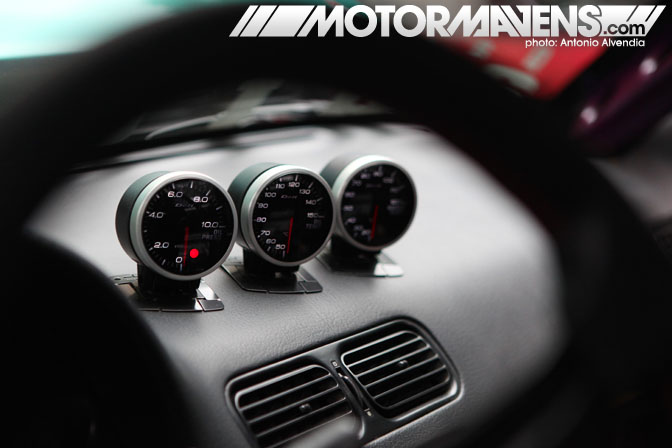[MoCH] Project D
 •
by
•
by sto kila bazuki

Today I will show you my one and only love, drift.


History
Its believed that all began in the 1970s, a man named Kunimitsu Takahashi was the father of the new driving style which later became popular in the touge (mountain pass) races. Approaching a corner at near full speed, he would hit the apex and create a very large slip angle. Using throttle techniques he would keep the car in this slip angle until the straight and continue on.

The seed for new driving style was planted. Later Keiichi Tsuchia influenced by the Takahashi's driving began practicing his drifting skills on the mountain roads of Japan, and quickly gained a reputation amongst the racing crowd. Tsuchiya's popularity continued to grow with the illegal street racers and several popular car magazines and tuning garages agreed to produce the first touge video, 1987's "Pluspy".

This video is the influence of many professional drifters in Japan, and can still be seen on YouTube and features him driving his automotive love and the car he is connected with, the AE86 chassis Toyota Levin. When Tsuchiya was a freshman in circuit racing, he got his racing license suspended because of the illegal racing he was still doing (cause of the Drift Pluspy video). In the movie series Shuto Kousoku Trial, he advised street racers to leave the illegal racing scene if they want to become involved with professional racing. The seed of drifting now was a growing tree and the early fruits of that tree had become ripe to eat. In 1986, Carboy magazine created the first ever drift event and in 1988, along with Video Option magazine founder and chief editor, Daijiro Inada, created the second sanctioned drift event, Ikaten, and that event would lead to the creation of the D1 Grand Prix, Japan's premier drifting series.

Drifting has evolved into a competitive sport where drivers compete mostly in rear-wheel-drive cars, to earn points from judges based on various factors (speed, angle, showmanship and line taken through a corner or set of corners). At the top levels of competition, the D1 Grand Prix in Japan pioneered the sport. Others such as Formula D in the United States, King of Europe and the British Drift Championships in Europe, WDS in China, Formula Drift Asia in the Malaysia/Singapore/Thailand/Indonesia and the NZ Drift Series in New Zealand have come along to further expand it into a legitimate motor sport worldwide. The drivers within these series were originally influenced by the pioneers from D1 Japan and are able to keep their cars sliding for extended periods of time, often linking several turns.
Other factor for spreathing the drift culture besides already mentioned. Many mangas in which mangakas (people who draw manga) showed ther love to the cars and the passes, excample- Initial D. In Initial D young boy named Fujiwara Takumi unconsusly grows his love towards his Toyota AE86 (hachi- roku), the character is actually based on Keiichi Tsuchia.


Cars
The cars are the drivers pride, they are everyting. Drifters wait for the payday just to buy the carpart that they wanted so bad.
A proper mechanical limited slip differential (LSD) is considered almost essential for drifting. Attempting to drift with an open or viscous differential in a sustained slide generally yields relatively less impressive results. The clutches on drift cars tend to be very tough ceramic brass button or multiple-plate varieties, for durability, as well as to allow rapid "clutch kick" techniques to upset the balance of the car. Gear sets may be replaced with closer ratios to keep the engine in the power band. These may be coarser dog engagement straight cut gears instead of synchronised helical gears, for durability and faster shifting at the expense of noise and refinement. Wealthier drifters may use sequential gearboxes to make gear selection easier and faster, while sequential shift lever adapters can be used to make shifts easier without increasing shift time.
Because of the large centripetal force encountered during drifting, drivers find it preferable to be retained firmly by a bucket seat and harness.

The steering wheel should be relatively small, dished, and perfectly round, so that it can be released and allowed to spin through the hands as the caster returns the front wheels to center. The locking knob on the hand brake is usually replaced with a spin turn knob; this stops the hand brake locking on when pulled. Some drivers move the hand brake location or add an extra hydraulic hand brake actuator for greater braking force. Many drivers make use of additional gauges to monitor such things as boost levels, oil, intake and coolant temperatures.


Mainly the cars that are used for drifting are RWD (rear wheel drive), but that doesn't mean that FWD and AWD can't drift.
http://youtu.be/JQMQkMvRG3I even tho it doesn't look good as drifting with RWD.
Popular drift cars:
Nissan 180/ 200/ 240 SX, Nissan Silvia S13, Nissan Sileighty (180 with Silvia front), Nissan Silvia S14/S15, Nissan Skyline R32/R33/R34, Nissan 350Z
Toyota AE86, Toyota Altezza, Toyota Supra, Toyota Cressida, Toyota MR2
Mazda RX-7/ RX-8, Mazda MX-5 (Miata)

Gallery
 Kawabata Masato with his 180 sx and his legendary reversed entry.
Kawabata Masato with his 180 sx and his legendary reversed entry. Sileighty and RX-8 tandem
Sileighty and RX-8 tandem The so called Drift Train
The so called Drift Train
That would be all



Minister of Culture & History: Nanashi Senshi
Vice Minister of Culture & History: Turt037, sto kila bazuki
History Director: sto kila bazuki
Graphics Director: Turt037


Comments
SHOUT
Project D
www.erepublik.com/en/article/2413059/1/20
GIFS
http://31.media.tumblr.com/tumblr_m5sk9q6pym1qesypno1_500.gif
http://iliketowastemytime.com/sites/default/files/amazing-gif-pt3-drifting-240.gif
http://media3.giphy.com/media/EEiaJD7rzjQA/giphy.gif
I'm not interested in anything related to cars but the article is informative.
Vv
V 😁
v